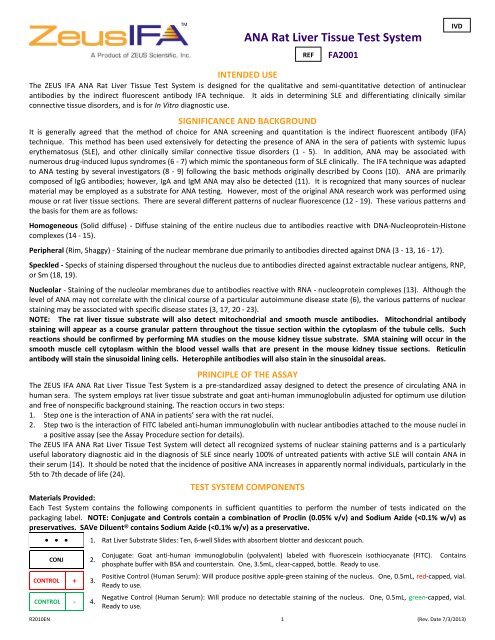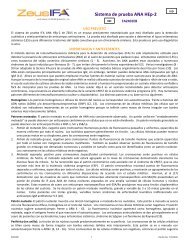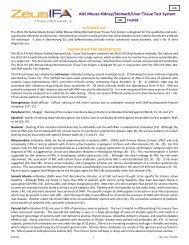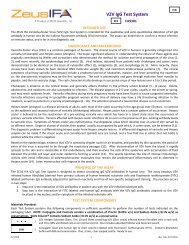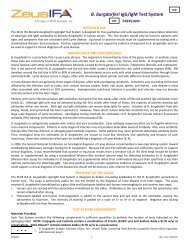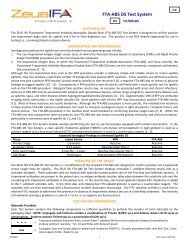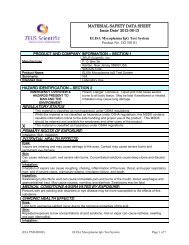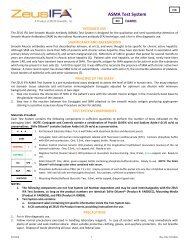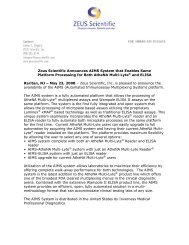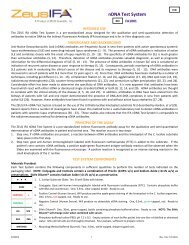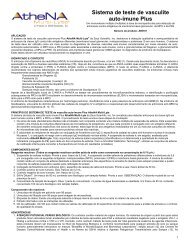English - ZEUS Scientific
English - ZEUS Scientific
English - ZEUS Scientific
You also want an ePaper? Increase the reach of your titles
YUMPU automatically turns print PDFs into web optimized ePapers that Google loves.
TM<br />
ANA Rat Liver Tissue Test System<br />
REF<br />
FA2001<br />
IVD<br />
INTENDED USE<br />
The <strong>ZEUS</strong> IFA ANA Rat Liver Tissue Test System is designed for the qualitative and semi-quantitative detection of antinuclear<br />
antibodies by the indirect fluorescent antibody IFA technique. It aids in determining SLE and differentiating clinically similar<br />
connective tissue disorders, and is for In Vitro diagnostic use.<br />
SIGNIFICANCE AND BACKGROUND<br />
It is generally agreed that the method of choice for ANA screening and quantitation is the indirect fluorescent antibody (IFA)<br />
technique. This method has been used extensively for detecting the presence of ANA in the sera of patients with systemic lupus<br />
erythematosus (SLE), and other clinically similar connective tissue disorders (1 - 5). In addition, ANA may be associated with<br />
numerous drug-induced lupus syndromes (6 - 7) which mimic the spontaneous form of SLE clinically. The IFA technique was adapted<br />
to ANA testing by several investigators (8 - 9) following the basic methods originally described by Coons (10). ANA are primarily<br />
composed of IgG antibodies; however, IgA and IgM ANA may also be detected (11). It is recognized that many sources of nuclear<br />
material may be employed as a substrate for ANA testing. However, most of the original ANA research work was performed using<br />
mouse or rat liver tissue sections. There are several different patterns of nuclear fluorescence (12 - 19). These various patterns and<br />
the basis for them are as follows:<br />
Homogeneous (Solid diffuse) - Diffuse staining of the entire nucleus due to antibodies reactive with DNA-Nucleoprotein-Histone<br />
complexes (14 - 15).<br />
Peripheral (Rim, Shaggy) - Staining of the nuclear membrane due primarily to antibodies directed against DNA (3 - 13, 16 - 17).<br />
Speckled - Specks of staining dispersed throughout the nucleus due to antibodies directed against extractable nuclear antigens, RNP,<br />
or Sm (18, 19).<br />
Nucleolar - Staining of the nucleolar membranes due to antibodies reactive with RNA - nucleoprotein complexes (13). Although the<br />
level of ANA may not correlate with the clinical course of a particular autoimmune disease state (6), the various patterns of nuclear<br />
staining may be associated with specific disease states (3, 17, 20 - 23).<br />
NOTE: The rat liver tissue substrate will also detect mitochondrial and smooth muscle antibodies. Mitochondrial antibody<br />
staining will appear as a course granular pattern throughout the tissue section within the cytoplasm of the tubule cells. Such<br />
reactions should be confirmed by performing MA studies on the mouse kidney tissue substrate. SMA staining will occur in the<br />
smooth muscle cell cytoplasm within the blood vessel walls that are present in the mouse kidney tissue sections. Reticulin<br />
antibody will stain the sinusoidal lining cells. Heterophile antibodies will also stain in the sinusoidal areas.<br />
PRINCIPLE OF THE ASSAY<br />
The <strong>ZEUS</strong> IFA ANA Rat Liver Tissue Test System is a pre-standardized assay designed to detect the presence of circulating ANA in<br />
human sera. The system employs rat liver tissue substrate and goat anti-human immunoglobulin adjusted for optimum use dilution<br />
and free of nonspecific background staining. The reaction occurs in two steps:<br />
1. Step one is the interaction of ANA in patients’ sera with the rat nuclei.<br />
2. Step two is the interaction of FITC labeled anti-human immunoglobulin with nuclear antibodies attached to the mouse nuclei in<br />
a positive assay (see the Assay Procedure section for details).<br />
The <strong>ZEUS</strong> IFA ANA Rat Liver Tissue Test System will detect all recognized systems of nuclear staining patterns and is a particularly<br />
useful laboratory diagnostic aid in the diagnosis of SLE since nearly 100% of untreated patients with active SLE will contain ANA in<br />
their serum (14). It should be noted that the incidence of positive ANA increases in apparently normal individuals, particularly in the<br />
5th to 7th decade of life (24).<br />
TEST SYSTEM COMPONENTS<br />
Materials Provided:<br />
Each Test System contains the following components in sufficient quantities to perform the number of tests indicated on the<br />
packaging label. NOTE: Conjugate and Controls contain a combination of Proclin (0.05% v/v) and Sodium Azide (
DIL SPE 5.<br />
BUF PBS 6.<br />
SAVe Diluent ® : One, 30mL, green-capped, bottle containing phosphate-buffered-saline. Ready to use. NOTE: The SAVe<br />
Diluent ® will change color when combined with serum.<br />
Phosphate-buffered-saline (PBS): pH 7.2 ± 0.2. Empty contents of each buffer packet into one liter of distilled or deionized<br />
water. Mix until all salts are thoroughly dissolved. Four packets, sufficient to prepare 4 liters.<br />
MNTMED<br />
7. Mounting Media (Buffered Glycerol): Two, 3.0mL, white-capped, dripper tipped vials.<br />
NOTES:<br />
1. The following components are not Test System Lot Number dependent and may be used interchangeably with the <strong>ZEUS</strong><br />
IFA Test Systems, as long as the product numbers are identical: SAVe Diluent ® (Product #: FA005CC), Mounting Media<br />
(Product #: FA0009S), and PBS (Product #: 0008S).<br />
2. Test System also contains:<br />
a. Component Label containing lot specific information inside the Test System box.<br />
b. A CD containing all <strong>ZEUS</strong> IFA Product Inserts, providing instructions for use.<br />
PRECAUTIONS<br />
1. For In Vitro diagnostic use.<br />
2. Follow normal precautions exercised in handling laboratory reagents. In case of contact with eyes, rinse immediately with<br />
plenty of water and seek medical advice. Wear suitable protective clothing, gloves, and eye/face protection. Do not breathe<br />
vapor. Dispose of waste observing all local, state, and federal laws.<br />
3. The wells of the Slide do not contain viable organisms. However, consider the Slide potentially bio-hazardous materials and<br />
handle accordingly.<br />
4. The Controls are potentially bio-hazardous materials. Source materials from which these products were derived were found<br />
negative for HIV-1 antigen, HBsAg and for antibodies against HCV and HIV by approved test methods. However, since no test<br />
method can offer complete assurance that infectious agents are absent, these products should be handled at the Bio-safety<br />
Level 2 as recommended for any potentially infectious human serum or blood specimen in the Centers for Disease<br />
Control/National Institutes of Health manual “Biosafety in Microbiological and Biomedical Laboratories”: current edition; and<br />
OSHA’s Standard for Bloodborne Pathogens (20).<br />
5. Adherence to the specified time and temperature of incubations is essential for accurate results. All reagents must be allowed<br />
to reach room temperature (20 - 25°C) before starting the assay. Return unused reagents to their original containers<br />
immediately and follow storage requirements.<br />
6. Improper washing could cause false positive or false negative results. Be sure to minimize the amount of any residual PBS, by<br />
blotting, before adding Conjugate. Do not allow the wells to dry out between incubations.<br />
7. The SAVe Diluent ® , Conjugate, and Controls contain Sodium Azide at a concentration of
MATERIALS REQUIRED BUT NOT PROVIDED<br />
1. Small serological, Pasteur, capillary, or automatic pipettes.<br />
2. Disposable pipette tips.<br />
3. Small test tubes, 13 x 100mm or comparable.<br />
4. Test tube racks.<br />
5. Staining dish: A large staining dish with a small magnetic mixing set-up provides an ideal mechanism for washing Slides between<br />
incubation steps.<br />
6. Cover slips, 24 x 60mm, thickness No. 1.<br />
7. Distilled or deionized water.<br />
8. Properly equipped fluorescence microscope.<br />
9. 1 Liter Graduated Cylinder.<br />
10. Laboratory timer to monitor incubation steps.<br />
11. Disposal basin and disinfectant (i.e.: 10% household bleach – 0.5% Sodium Hypochlorite).<br />
The following filter systems, or their equivalent, have been found to be satisfactory for routine use with transmitted or incident light<br />
darkfield assemblies:<br />
Transmitted Light<br />
Light Source: Mercury Vapor 200W or 50W<br />
Excitation Filter Barrier Filter Red Suppression Filter<br />
KP490 K510 or K530 BG38<br />
BG12 K510 or K530 BG38<br />
FITC K520 BG38<br />
Light Source: Tungsten – Halogen 100W<br />
KP490 K510 or K530 BG38<br />
Incident Light<br />
Light Source: Mercury Vapor 200, 100, 50 W<br />
Excitation Filter Dichroic Mirror Barrier Filter Red Suppression Filter<br />
KP500 TK510 K510 or K530 BG38<br />
FITC TK510 K530 BG38<br />
Light Source: Tungsten – Halogen 50 and 100 W<br />
KP500 TK510 K510 or K530 BG38<br />
FITC TK510 K530 BG38<br />
SPECIMEN COLLECTION<br />
1. <strong>ZEUS</strong> <strong>Scientific</strong> recommends that the user carry out specimen collection in accordance with CLSI document M29: Protection of<br />
Laboratory Workers from Occupationally Acquired Infectious Diseases. No known test method can offer complete assurance<br />
that human blood samples will not transmit infection. Therefore, all blood derivatives should be considered potentially<br />
infectious.<br />
2. Only freshly drawn and properly refrigerated sera obtained by approved aseptic venipuncture procedures with this assay (28,<br />
29). No anticoagulants or preservatives should be added. Avoid using hemolyzed, lipemic, or bacterially contaminated sera.<br />
3. Store sample at room temperature for no longer than 8 hours. If testing is not performed within 8 hours, sera may be stored<br />
between 2 - 8°C, for no longer than 48 hours. If delay in testing is anticipated, store test sera at –20°C or lower. Avoid multiple<br />
freeze/thaw cycles which may cause loss of antibody activity and give erroneous results.<br />
STORAGE CONDITIONS<br />
Unopened Test System.<br />
Mounting Media, Conjugate, SAVe Diluent ® , Slides, Positive and Negative Controls.<br />
Rehydrated PBS (Stable for 30 days).<br />
Phosphate-buffered-saline (PBS) Packets.<br />
ASSAY PROCEDURE<br />
1. Remove Slides from refrigerated storage and allow them to warm to room temperature (20 - 25°C). Tear open the protective<br />
envelope and remove Slides. Do not apply pressure to flat sides of protective envelope.<br />
2. Identify each well with the appropriate patient sera and Controls. NOTE: The Controls are intended to be used undiluted.<br />
Prepare a 1:20 dilution (e.g.: 10µL of serum + 190µL of SAVe Diluent ® or PBS) of each patient serum. The SAVe Diluent ® will<br />
undergo a color change confirming that the specimen has been combined with the Diluent.<br />
Dilution Options:<br />
R2010EN 3 (Rev. Date 7/3/2013)
a. As an option, users may prepare initial sample dilutions using PBS, or Zorba-NS (Zorba-NS is available separately. Order<br />
Product Number FA025 – 2, 30mL bottles).<br />
b. Users may titrate the Positive Control to endpoint to serve as a semi-quantitative (1+ Minimally Reactive) Control. In such<br />
cases, the Control should be diluted two-fold in SAVe Diluent ® or PBS. When evaluated by <strong>ZEUS</strong> <strong>Scientific</strong>, an endpoint<br />
dilution is established and printed on the Positive Control vial (± one dilution). It should be noted that due to variations<br />
within the laboratory (equipment, etc.), each laboratory should establish its own expected end-point titer for each lot of<br />
Positive Control.<br />
c. When titrating patient specimens, initial dilutions should be prepared in SAVe Diluent ® , PBS, or Zorba-NS and all<br />
subsequent dilutions should be prepared in SAVe Diluent ® or PBS only. Titrations should not be prepared in Zorba-NS.<br />
3. With suitable dispenser (listed above), dispense 20µL of each Control and each diluted patient sera in the appropriate wells.<br />
4. Incubate Slides at room temperature (20 - 25°C) for 30 minutes.<br />
5. Gently rinse Slides with PBS. Do not direct a stream of PBS into the test wells.<br />
6. Wash Slides for two, 5 minute intervals, changing PBS between washes.<br />
7. Remove Slides from PBS one at a time. Invert Slide and key wells to holes in blotters provided. Blot Slide by wiping the reverse<br />
side with an absorbent wipe. CAUTION: Position the blotter and Slide on a hard, flat surface. Blotting on paper towels may<br />
destroy the Slide matrix. Do not allow the Slides to dry during the test procedure.<br />
8. Add 20µL of Conjugate to each well.<br />
9. Repeat steps 4 through 7.<br />
10. Apply 3 - 5 drops of Mounting Media to each Slide (between the wells) and coverslip. Examine Slides immediately with an<br />
appropriate fluorescence microscope.<br />
NOTE: If delay in examining Slides is anticipated, seal coverslip with clear nail polish and store in refrigerator. It is recommended<br />
that Slides be examined on the same day as testing.<br />
QUALITY CONTROL<br />
1. Every time the assay is run, a Positive Control, a Negative Control and a Buffer Control must be included.<br />
2. It is recommended that one read the Positive and Negative Controls before evaluating test results. This will assist in establishing<br />
the references required to interpret the test sample. If Controls do not appear as described, results are invalid.<br />
a. Negative Control - characterized by the absence of specific fluorescence and a red, or dull green, background staining of all<br />
cells due to counterstain.<br />
b. Positive Control - characterized by apple-green fluorescence. The homogeneous staining pattern is a diffused uniform<br />
staining of the entire nucleus.<br />
3. Additional Controls may be tested according to guidelines or requirements of local, state, and/or federal regulations or<br />
accrediting organizations.<br />
NOTES:<br />
a. The intensity of the observed fluorescence may vary with the microscope and filter system used.<br />
b. Non-specific reagent trapping may exist. It is important to adequately wash slides to eliminate false positive results.<br />
c. Non-nuclear staining of the Rat Liver substrate may be observed with some human sera. Report nuclear staining results<br />
only and disregard non-nuclear staining.<br />
INTERPRETATION OF RESULTS<br />
1. Titers less than 1:20 are considered negative.<br />
2. Positive test: A positive reaction is the presence of any pattern of nuclear apple green staining observed at a 1:20 dilution, based<br />
on 1+ to 4+ scale of staining intensity. 1+ is considered a weak reaction, and a 4+ a strong reaction. All sera positive at 1:20<br />
should be titered to end point dilution. This is accomplished by making a 1:20, 1:40, 1:80, etc., serial dilution of all positives.<br />
The end point is the highest dilution that produces a 1+ positive reaction.<br />
3. Homogeneous patterns with peripheral accentuation are frequently found in sera from patients with SLE.<br />
Interpretation According to Pattern of Nuclear Staining<br />
Pattern Disease Most Frequently Found In References<br />
Homogeneous<br />
High Titer<br />
Low Titer<br />
SLE<br />
Rheumatoid Arthritis and other diseases<br />
(3,8,9,17)<br />
(1)<br />
Peripheral SLE (2,8,9,17)<br />
Speckled<br />
Scleroderma, Raynaud’s Syndrome, Sjögren’s Syndrome, Mixed Connective<br />
Tissue Disease<br />
(12,25,26)<br />
Nucleolar Scleroderma (27)<br />
LIMITATIONS OF THE ASSAY<br />
1. The <strong>ZEUS</strong> IFA ANA Rat Liver Tissue Test System is a laboratory diagnostic aid and by itself is not diagnostic. Positive ANA may be<br />
found in apparently healthy people. It is therefore imperative that ANA results be interpreted in light of the patient’s clinical<br />
condition by a medical authority.<br />
R2010EN 4 (Rev. Date 7/3/2013)
2. SLE patients undergoing steroid therapy may have negative test results.<br />
3. Many commonly prescribed drugs may induce ANA (6, 7).<br />
4. Some nuclear staining patterns may be masked at a 1:20 dilution. Serial dilution of these sera will unmask these patterns.<br />
5. No definitive association between the pattern of nuclear fluorescence and any specific disease state is intended with this<br />
product.<br />
EXPECTED RESULTS<br />
The expected value in the normal population is negative. However, apparently healthy individuals may contain ANA in their sera<br />
(24). This percentage increases with aging, particularly in the 7th decade of life.<br />
PERFORMANCE CHARACTERISTICS<br />
The <strong>ZEUS</strong> IFA ANA Rat Liver Tissue Test System was tested in parallel with a reference procedure described in the literature. Routine<br />
ANA testing was performed by both procedures on 434 patient specimens. Of these 434 sera, 116 were positive by both<br />
procedures. The <strong>ZEUS</strong> IFA ANA Rat Liver Tissue Test System showed 97% agreement with respect to positive and negative results,<br />
and 100% with respect to staining pattern. Of the 29 discrepancies in titer, the <strong>ZEUS</strong> procedure was one dilution lower in 16<br />
specimens, while the reference procedure was lower in 13 specimens. Of the 16 specimens with lower titers by the <strong>ZEUS</strong> procedure,<br />
all were one dilution discrepancies, and 13 of these 16 involved specimens that were negative by the <strong>ZEUS</strong> procedure and positive at<br />
1:20 by the reference procedure.<br />
Specificity: Although most ANA are of the IgG class, the goat anti-human immunoglobulin conjugate used in this test system<br />
produces precipitin reactions on immunoelectrophoretic analysis against IgG, IgA, and IgM immunoglobulins. This reagent is<br />
considered to be polyvalent.<br />
REFERENCES<br />
1. Barnett EV: Mayo. Clin. Proc. 44:645, 1969.<br />
2. Burnham TK, Fine G, Neblett TR: Ann. Int. Med. 63:9, 1966.<br />
3. Casals SP, Friou GJ, Meyers LL: Arthritis Rheum. 7:379, 1964.<br />
4. Condemi JJ, Barnett EV, Atwater EC, et al: Arthritis Rheum. 8:1080, 1965.<br />
5. Dorsch CA, Gibbs CB, Stevens MB, Shelman LE: Ann. Rheum. Dis. 28:313, 1969.<br />
6. Dubois EL: J. Rheum. 2:204, 1975.<br />
7. Alarcon-Segovia D, Fishbein E: J. Rheum. 2:167, 1975.<br />
8. Friou GJ: J. Clin. Invest. 36:890, 1957.<br />
9. Friou GJ, Finch SC, Detre KD: J. Immunol. 80:324, 1958.<br />
10. Coons AH, Creech H, Jones RN, et al : J. Immunol. 80:324, 1958.<br />
11. Barnett EV, North AF, Condemi JJ, Jacox RF, Vaughn JH: Ann. Intern. Med. 63:100, 1965.<br />
12. Beck JS: Lancet. 1:1203, 1961.<br />
13. Beck JS: Scot. Med. J. 8:373, 1963.<br />
14. Lachman PJ, Kunkel HG: Lancet, 2:436, 1961.<br />
15. Friou GJ: Arthritis and Rheum. 7:161, 1964.<br />
16. Anderson JR, Gray KG, Beck JS, et al: Ann. Rheum. Dis. 21:360, 1962.<br />
17. Luciano A, Rothfield NF: Ann. Rheum. Dis. 32:337, 1973.<br />
18. Beck JS: Lancet. 1:241, 1962.<br />
19. Tan EM, Kunkel HG: J. Immunol. 96:464, 1966.<br />
20. Hall AP, Bardawil WA, Bayles TB, et al: N. Engl. J. Med. 263:769, 1960.<br />
21. Pollack VE: N. Engl. J. Med. 271:165, 1964.<br />
22. Raskin J: Arch. Derm. 89:569, 1964.<br />
23. Beck JS, Anderson JR, Gray KG, Rowell NR: Lancet. 2:1188, 1963.<br />
24. Whittingham S, Irwin J, MacKay IR, et al: Aust. Ann. Med. 18:130, 1969.<br />
25. Sharp GC, Irvin WS, Tan EM, et al: Am. J. Med. 52:48, 1972.<br />
26. Burnham TK, Beglett TR, Fine G: Am. J. Clin. Path. 50:48, 1972.<br />
27. Textbook of Immunopathology. Vol. II. ed by Miescher P and Muller-Eberhard HJ. New York, Grune and Stratton, 1969.<br />
28. Procedures for the collection of diagnostic blood specimens by venipuncture - Second Edition: Approved Standard (1984). Published by National Committee for Clinical<br />
Laboratory Standards.<br />
29. Procedures for the Handling and Processing of Blood Specimens. NCCLS Document H18-A, Vol. 10, No. 12, Approved Guideline, 1990.<br />
30. U.S. Department of Labor, Occupational Safety and Health Administration: Occupational Exposure to Bloodborne Pathogens, Final Rule. Fed. Register 56:64175-64182,<br />
1991.<br />
<strong>ZEUS</strong> <strong>Scientific</strong>, Inc.<br />
200 Evans Way, Branchburg, New Jersey, 08876, USA<br />
Toll Free (U.S.): 1-800-286-2111<br />
International: +1 908-526-3744<br />
Fax: +1 908-526-2058<br />
<strong>ZEUS</strong> IFA and SAVe Diluent ® are trademarks of <strong>ZEUS</strong> <strong>Scientific</strong>, Inc.<br />
Customer Service E-mail: orders@zeusscientific.com<br />
Technical Support E-mail: support@zeusscientific.com<br />
Website: www.zeusscientific.com<br />
© 2013 <strong>ZEUS</strong> <strong>Scientific</strong>, Inc. All Rights Reserved.<br />
R2010EN 5 (Rev. Date 7/3/2013)


